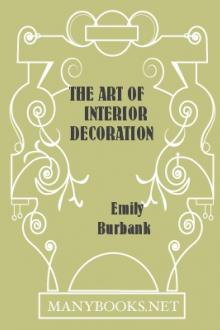The Art of Interior Decoration by Emily Burbank (good summer reads TXT) 📕

- Author: Emily Burbank
- Performer: -
Book online «The Art of Interior Decoration by Emily Burbank (good summer reads TXT) 📕». Author Emily Burbank
In such a cottage, the living-room has a raftered ceiling, the sidewalls, woodwork, settles by the fireplaces, open bookcases and floor, are all stained dark walnut. The floor colour is very dark, the sidewalls, woodwork and book shelves are a trifle lighter, and the ceiling boards still lighter between the almost black, heavy rafters. The mission furniture is dark brown, the hangings and cushions are of mahogany-coloured corduroy, and the floor is strewn with skins of animals. There are no pictures, the idea being to avoid jarring notes in another key. Instead, copper and brass bowls contribute a note of variety, as well as large jars filled with great branches of flowers, gathered in the nearby woods. The chimney is exposed. It and the large open fireplace are of rough, dark mottled brick.
A room of this character would be utterly spoiled by introducing white as ornaments, table covers, window curtains or picture-mats; it is a colour scheme of dull wood-browns, old reds and greens in various tones. If you want your friends' photographs about you in such a room, congregate them on one or two shelves above your books.
CHAPTER XXVI TREATMENT OF AN INEXPENSIVE BEDROOMThe experience of the author is that the most attractive, inexpensive furniture is that made by the Leavens factory in Boston. This furniture is so popular with all interior decorators that it needs no further advertising. Order for each single iron bed two foot boards, instead of a head and a footboard. This the factory will supply upon demand. Then have your bed painted one of the colours you have chosen as in the colour scheme for your room. Say, the prevailing note of your chintz. Have two rolls made, to use at the head and foot (which are now of equal height) and cover these and the bed with chintz, or, if preferred, with sun-proof material in one of the other colours in your chintz. By this treatment your cheap iron bed of ungainly proportions, has attained the quality of an interesting, as well as unique, "day-bed."
Two designs for day-beds which are done in colours to suit the scheme of any room.
These beds are fitted with box springs and a luxurious mattress of feathers or down, covered with silk or chintz, coverlet and cushions of similar material, in colours harmonising with beds. If desired, these lounges can be made higher from the floor.
The most attractive cheap bureau is one ordered "in the plain" from the factory, and painted like the bed. If you would entirely remove the factory look, have the mirror taken off the bureau and hang it on the wall over what, by your operation, has become a chest of drawers. If you want a long mirror in your rooms, the cheapest variety is mirror glass, fastened to the back of doors with picture moulding to match woodwork. This is also the cheapest variety of over-mantel mirrors. We have seen it used with great success, let into walls of narrow halls and bedrooms and framed with a dull-gold moulding in the style of room.
For chairs, use the straight wooden ones which are made to match the bureau, and paint them like the bed and bureau.
For comfortable arm-chairs, wicker ones with chintz-covered pads for seat and back are best for the price, and these can also be painted.
Cheap tables, which match the bureau, when painted will do nicely as a small writing-table or a night-table for water, clock, book, etc.
If the floors are new and of hard wood, wax them and use a square of plain velvet carpet in a dark tone of your dominant colour. Or if economy is your aim, use attractive rag rugs which are very cheap and will wash.
If your floors are old and you intend using a large velvet square, paint the edges of the floor white, or some pale shade to match the colour of the walls. Or, use filling all over the floor. If you cannot afford either and must use small rugs, stain or paint your floors a dark colour, to be practical, and use only necessary rugs; that is, one before bed, bureau and fireplace.
Sofas are always expensive. That is one reason for advising that beds be treated like "day-beds."
Wall papers, at ten cents a roll, come in charming colours and designs, and with a few cheap French coloured prints, framed in passepartout, your room is attractive at once.
If your prints are black and white use broad passepartout in same colour as the wall paper, only a tone deeper. If you use favourite photographs, suppress all margins and frame with narrow black passepartout.
For curtains use one of the sixty-or seventy-cent chintzes which come in attractive designs and colours, or what is still cheaper, sun-proof material, fifty inches wide (from $1.10 to $1.50 a yard), and split it in half for curtains, edging them with a narrow fringe of a contrasting colour which appears in the chintz of chair-pads. Another variety of cheap curtains is heavy cream scrim with straps (for looping back) and valance of chintz. These come cheaper than all chintz curtains and are very effective, suggesting the now popular and expensive combination of plain toned taffetas combined with chintz.
Use for sash curtains plain scrim or marquesette.
Let your lamps be made of inexpensive one-toned pottery vases, choosing for these still another colour which appears in the chintz. The lamp shades can be made of a pretty near-silk, in a plain colour, with a fringe made up of one, two or three of the colours in the chintz.
If you happen to have your heart set on deep rose walls and your bedroom furniture is mahogany, find a chintz with rose and French blue, and then cover your arm-chair pads and bed with chintz, but make your curtains of blue sun-proof material, having a narrow fringe of rose, and use a deep rose carpet, or rugs, or if preferred, a dull brown carpet to harmonise with the furniture. A plain red Wilton carpet will dye an artistic deep mulberry brown. They are often bought in the red and dyed to get this shade of brown.
For attractive cheap dining-room furniture, buy simple shapes, unfinished, and have the table, sideboard and chairs painted dark or light, as you prefer.
In your dining-room and halls, if the house is old and floors bad, and economy necessary, use a solid dark linoleum, either deep blue or red, and have it waxed, as an economical measure as well as to improve its appearance.
In a small home, where no great formality is observed, well chosen doilies may be used on all occasions, instead of table cloths. By this expedient you suppress one large item on the laundry bill, the care of the doilies in such cases falling to the waitress.
To make comfortable, convenient and therefore livable, a part of a house, formerly an attic, or an extension with small rooms and low ceilings, seems to be the special province of a certain type of mind, which works best when there is a tax on the imagination.
When reclaiming attic rooms, one of the problems is how to get wall space, especially if there are dormer windows and very slanting ceilings. One way, is to place a dressing table in the dormer, under windows, covering the sides of the dormer recess with mirror glass, edged with narrow moulding. The dressing-table is not stationary, therefore it can be easily moved by a maid, when the rooms are cleaned.
CHAPTER XXVII TREATMENT OF A GUEST ROOM(Where economy is not an item of importance)
Here we can indulge our tastes for beautiful quality of materials and fine workmanship, as well as good line and colour, so we describe a room which has elegant distinction and atmosphere, yet is not a so-called period room—rather a modern room, in the sense that it combines beautiful lines and exquisite colouring with every modern development for genuine comfort and convenience.
The walls are panelled and painted a soft taupe—there are no pictures; simply one very beautiful mirror in a dull-gold frame, a Louis XVI reproduction.
In another suite we have a boudoir done in sage greens and soft browns. The curtains of taffeta, in stripes of the two colours. Two tiers of creme net form sash curtains.
The carpet is a rich mulberry brown, day-bed a reproduction of an antique, painted in faded greens with panier fleuri design on back, in lovely faded colours, taffeta cushions of sage green and an occasional note about the room of mulberry and dull blue. Electric light shades are of decorated parchment paper.
Really an enchanting nest, and as it is in a New York apartment, and occasionally used as a bedroom, a piece of furniture has been designed for it similar to the wardrobe shown in picture, only not so high. The glass door, when open, disclose a toilet table, completely fitted out, the presence of which one would never suspect.
The carpet made of dark taupe velvet covers the entire floor. The furniture is Louis XV, of the wonderful painted sort, the beautiful bed with its low head and foot boards exactly the same height, curving backward; the edges a waved line, the ground-colour a lovely pistache green, and the decoration gay old-fashioned garden flowers in every possible shade. The bureau has three or four drawers and a bowed front with clambering flowers. These two pieces, and a delightful night-table are exact copies of the Clyde Fitch set in the Cooper Hewitt Museum, at New York; the originals are genuine antiques, and their colour soft from age.
A graceful dressing-table, with winged mirrors, has been designed to go with this set, and is painted like the bureau. The glass is a modern reproduction of the lovely old eighteenth century mirror glass which has designs cut into it, forming a frame.
For chairs, all-over upholstered ones are used, of good lines and proportions; two or three for comfort, and a low slipper-chair for convenience. These are covered in a chintz with a light green ground, like the furniture, and flowered in roses and violets, green foliage and lovely blue sprays.
The window curtains are of soft, apple-green taffeta, trimmed with a broad puffing of the same silk, edged on each side by black moss-trimming, two inches wide. These curtains hang from dull-gold cornices of wood, with open carving, through which one gets glimpses of the green taffeta of the curtains.
The sash-curtains are of the very finest cream net, and the window shades are of glazed linen, a deep cream ground, with a pattern showing a green lattice over which climb pink roses. The shades are edged at the bottom with a narrow pink fringe.
The bed has a cover of green taffeta exactly like curtains, with the same trimming of puffed taffeta, edged with a black moss-trimming.
The mantelpiece is true to artistic standards and realises the responsibility of its position as keynote to the room. Placed upon it are a beautiful old clock and two vases, correct as to line and colour.
Always be careful not to spoil a beautiful mantel or beautiful ornaments by having them out of proportion one with the other. Plate XXIV shows a mantel which fails as a composition because the bust, an original by Behnes, beautiful in itself, is too heavy for the mantel it stands on and too large for the mirror which reflects it





Comments (0)